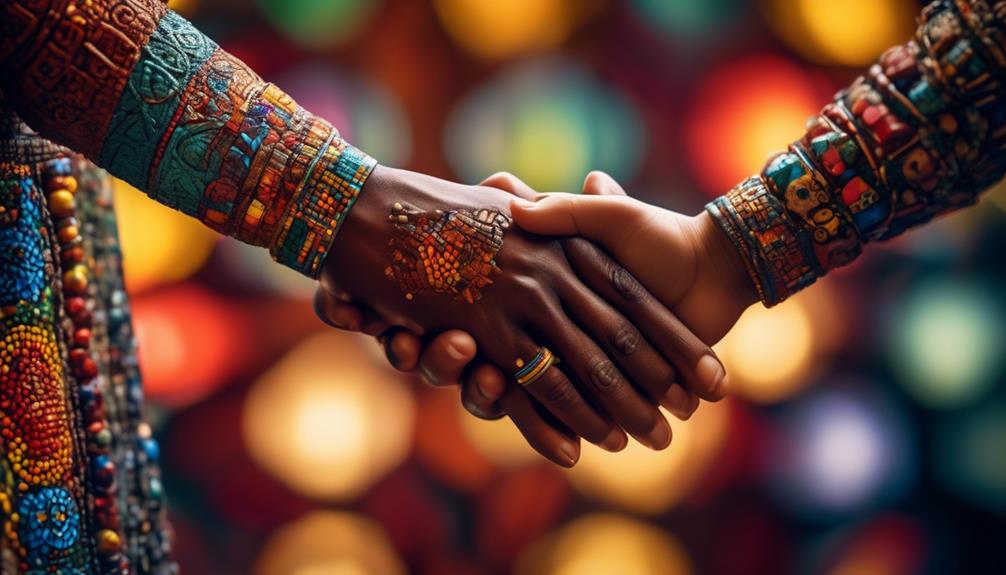How to Navigate Cultural Differences in Relationships

Tips for navigating cultural differences in relationships:
- Effective communication strategies
- Embracing differences
- Confronting stereotypes head-on
Importance of Cultural Understanding
Understanding and respecting cultural differences is essential for maintaining healthy and successful relationships. In today's interconnected world, cross-cultural relationships are becoming increasingly common. But navigating these relationships can be challenging, as cultural sensitivity plays a crucial role.
Cultural sensitivity means being aware of and respecting the customs, traditions, and values of different cultures. It involves being open-minded and willing to learn about and adapt to different ways of thinking and behaving. Without cultural sensitivity, misunderstandings, conflicts, and even resentment can arise in relationships.
To have a truly successful cross-cultural relationship, you must be willing to put in the effort to understand and appreciate each other's cultural backgrounds. This means actively educating yourself about your partner's culture, asking questions, and listening with an open mind. It also means being mindful of cultural differences in communication styles, social norms, and expectations.
Effective Communication Strategies
To effectively navigate cultural differences in relationships, it's imperative to master communication strategies that cut through cultural barriers and foster understanding. Active listening is a crucial skill that allows you to truly hear and understand what the other person is saying. It requires giving your full attention, suspending judgment, and asking clarifying questions. By actively listening, you show respect and validate the other person's perspective, helping to bridge cultural gaps.
Nonverbal communication is another essential aspect of effective communication. It includes gestures, facial expressions, body language, and tone of voice. Different cultures may interpret nonverbal cues differently, so it's vital to be aware of these differences and adapt accordingly. Pay attention to cues such as eye contact, hand gestures, and personal space to better understand the underlying messages being conveyed.
Additionally, it's essential to be aware of your own cultural biases and assumptions. Challenge your preconceived notions and be open to different ways of thinking and expressing oneself. Be willing to learn and adapt your communication style to accommodate cultural differences. Remember, effective communication is a two-way street, requiring both parties to make an effort to understand and be understood.
Mastering active listening and being mindful of nonverbal communication can help bridge the gap between different cultures and foster meaningful connections. By honing these communication strategies, you can navigate cultural differences in relationships with greater empathy, understanding, and respect.
Embracing Differences and Celebrating Similarities
Embrace the differences and celebrate the similarities in your relationship to foster a deep connection based on understanding and appreciation. In today's globalized world, cultural diversity is becoming increasingly prevalent in relationships. It's vital to acknowledge and celebrate this diversity, as it enriches our lives and brings new perspectives to the table.
To celebrate diversity, start by recognizing and appreciating the unique qualities that each culture brings to your relationship. Take the time to learn about each other's traditions, customs, and values. Engage in conversations that explore your cultural backgrounds and share personal experiences. By doing so, you'll foster empathy and understanding, creating a strong foundation for your relationship.
At the same time, it's important to find common ground and celebrate the similarities that bind you together. Discover shared interests, hobbies, or values that transcend cultural differences. These commonalities can help bridge any gaps and strengthen your connection.
Building Mutual Respect and Trust
You can't expect to build a healthy and successful relationship without mutual respect and trust.
It's time to address the elephant in the room – cultural differences.
To establish open communication and truly embrace these differences, you need to be willing to challenge your own beliefs and biases.
It's uncomfortable, it's controversial, but it's necessary for growth and understanding.
Establishing Open Communication
Establishing open communication in relationships requires a foundation of mutual respect and trust, which can be achieved through direct and honest conversations. Here are three ways to build trust and foster understanding in your relationship:
- Be transparent: Share your thoughts, feelings, and concerns openly and honestly. Avoid hiding or sugarcoating important information, as it can lead to misunderstandings and resentment.
- Listen actively: Pay attention to what your partner is saying without interrupting or jumping to conclusions. Show empathy and try to understand their perspective, even if it differs from your own.
- Address conflicts promptly: Don't let issues simmer and escalate. Instead, address them as soon as possible through calm and respectful discussions. Avoid blaming or criticizing, and instead focus on finding solutions together.
Embracing Cultural Differences
To build mutual respect and trust in your relationship, it's essential to embrace and celebrate the cultural differences between you and your partner.
Cultural appreciation isn't just about tolerating each other's customs and traditions; it goes beyond that. It requires actively seeking to understand and learn from each other's backgrounds.
Fostering inclusivity means creating an environment where both of you feel valued and respected for who you are. This requires open-mindedness and a willingness to challenge your own biases.
Embracing cultural differences can be challenging, but it's also an opportunity for growth and enrichment. By embracing diversity, you can create a stronger bond and a more harmonious relationship.
Navigating the intricate web of traditions and customs in a relationship can be a challenging endeavor. It requires patience, understanding, and a willingness to learn from each other. Here are a few tips to help you navigate the cultural customs and traditions that may arise in your relationship:
- Embrace diversity: Recognize that your partner's traditions and customs are a part of who they are. Embrace the opportunity to learn about their culture and appreciate the richness it adds to your relationship.
- Communicate openly: Discuss your own traditions and customs with your partner, and encourage them to do the same. Be open to compromise and find ways to incorporate both of your customs into your relationship.
- Respect boundaries: It's important to respect each other's boundaries when it comes to traditions and customs. If there are certain practices that make you uncomfortable, communicate this to your partner in a respectful manner and find a solution that works for both of you.
Navigating traditions and customs in a relationship requires effort and understanding from both partners. By embracing diversity, communicating openly, and respecting boundaries, you can create a relationship that's built on mutual respect and appreciation for each other's cultural backgrounds.
Addressing Stereotypes and Prejudices
Stereotypes and prejudices can poison a relationship, but addressing them head-on is crucial for growth and understanding. It's time to tackle these biases and promote inclusion in your relationship.
Biases can arise from cultural differences, societal norms, or personal experiences, but they have no place in a healthy relationship. Ignoring these biases will only allow them to fester and cause further harm. Instead, you must confront them directly and openly discuss your thoughts and feelings.
Start by acknowledging your own biases. We all have them, whether we realize it or not. Reflect on your beliefs and prejudices and be willing to challenge them. This self-awareness will help you approach conversations about biases with empathy and understanding.
Next, create a safe space for open dialogue with your partner. Encourage them to share their experiences and perspectives without judgment. Listen actively and validate their feelings. Remember, promoting inclusion means valuing and respecting their unique identity and culture.
Educate yourself and your partner about different cultures and identities. Read books, watch documentaries, and engage in conversations with people from diverse backgrounds. This will broaden your understanding and help you recognize and address biases more effectively.
Lastly, be an ally. Stand up against stereotypes and prejudices when you witness them, whether it's within your relationship or in your wider social circle. Use your privilege to amplify marginalized voices and promote inclusivity.
Addressing biases and promoting inclusion in your relationship requires effort and open-mindedness. It won't always be easy, but the rewards are worth it. By confronting stereotypes and prejudices head-on, you can build a stronger, more understanding, and more loving relationship.
Seeking Support and Mediation
Confronting biases and promoting inclusion in your relationship requires more than just personal reflection and open dialogue; seeking support and mediation can play a crucial role in navigating cultural differences.
It's time to recognize that you can't do it all on your own. Here's why seeking support and mediation is essential in addressing cultural differences:
- Building a Supportive Community: Surrounding yourself with a supportive community can provide you with a safe space to express your concerns and share your experiences. They can offer valuable insights and advice, helping you navigate the complexities of cultural differences. A supportive community can also provide a sense of belonging and validation, making you feel understood and accepted.
- Conflict Resolution: Cultural differences can often lead to conflicts in relationships. Seeking mediation from a neutral third party can help facilitate open and constructive communication. Mediators can provide guidance and help you find common ground, ensuring that conflicts are resolved in a fair and respectful manner.
- Gaining Different Perspectives: Seeking support and mediation allows you to gain different perspectives on cultural differences. By engaging with individuals from diverse backgrounds, you can broaden your understanding and challenge your own biases. This exposure to different viewpoints can foster empathy and promote mutual understanding in your relationship.
Continuous Learning and Growth
If you want your relationship to thrive amidst cultural differences, you better buckle up and embrace cultural diversity.
Don't be close-minded and stuck in your own ways, because that won't get you far.
Instead, be adaptable and willing to learn and grow from your partner's perspective.
It's all about communication and understanding, so get ready to put in the work and make your relationship stronger than ever.
Embrace Cultural Diversity
Embrace the richness of cultural diversity through continuous learning and growth. To navigate cultural differences in relationships, it's crucial to embrace cultural awareness and foster inclusivity. Here are three essential ways to do it:
- Challenge your assumptions: Recognize that your beliefs and values may differ from those of others. Be open-minded and willing to question your preconceived notions.
- Educate yourself: Take the initiative to learn about different cultures, traditions, and customs. Read books, watch documentaries, or engage in conversations with people from diverse backgrounds.
- Practice empathy: Put yourself in someone else's shoes and try to understand their perspective. Listen actively and show genuine interest in their experiences.
Embracing cultural diversity requires effort and continuous growth. By doing so, you can build stronger relationships and create a more inclusive and harmonious world.
Open-Mindedness and Adaptability
To successfully navigate cultural differences in relationships, you must be willing to continuously learn and grow, remaining open-minded and adaptable. Being open-minded means being receptive to new ideas, perspectives, and ways of doing things. It requires setting aside preconceived notions and embracing different customs and traditions. Adaptability, on the other hand, is about being flexible and adjusting your behavior and expectations to accommodate cultural differences. It means being willing to step outside of your comfort zone and embrace change. Both open-mindedness and adaptability are essential in building strong and harmonious relationships with individuals from different cultures. By practicing these qualities, you demonstrate your willingness to understand, respect, and embrace diversity, ultimately fostering a more inclusive and enriching relationship experience.
| Open-Mindedness | Adaptability |
|---|---|
| Receptive to new ideas | Flexible and adjustable |
| Embracing different customs and traditions | Willingness to step outside of comfort zone |
| Setting aside preconceived notions | Embracing change |
| Understanding and respect for diversity | Accommodating cultural differences |
| Fostering inclusive and enriching relationships | Building strong and harmonious relationships |
Communication and Understanding
Navigating cultural differences in relationships requires continuous learning and growth, particularly when it comes to communication and understanding. To effectively navigate these differences, it's important to cultivate cultural sensitivity and develop cross-cultural communication skills.
Here are three key points to keep in mind:
- Be open-minded: Approach conversations with curiosity and a willingness to learn about different cultural perspectives. Avoid making assumptions or jumping to conclusions.
- Practice active listening: Truly hear and understand what the other person is saying, without interrupting or imposing your own beliefs. Ask clarifying questions to ensure comprehension.
- Adapt your communication style: Recognize that different cultures may have different norms for communication. Be flexible and willing to adjust your approach to accommodate the other person's cultural background.
Frequently Asked Questions
Can Cultural Differences in a Relationship Be a Deal Breaker?
Cultural differences in a relationship can be a deal breaker if you're not willing to put in the effort to overcome barriers and find common ground. It takes understanding and compromise to make it work.
How Can One Effectively Communicate With a Partner From a Different Culture?
To effectively communicate with a partner from a different culture, you need to overcome language barriers and understand their cultural norms. This involves navigating differences in values and beliefs, which can be challenging but rewarding in a multicultural relationship.
Is It Necessary to Completely Embrace All Aspects of a Partner's Culture in a Relationship?
You don't have to fully embrace every aspect of your partner's culture in a relationship. Blending cultures and embracing differences can be a beautiful and enriching experience, but it's important to find a balance that works for both of you.
What Steps Can Be Taken to Build Trust and Respect in a Cross-Cultural Relationship?
To build trust and respect in a cross-cultural relationship, you need to focus on building bridges and being culturally sensitive. It's important to understand and appreciate each other's differences, and actively work towards creating a harmonious and inclusive partnership.
Blending traditions and customs in a relationship can be like juggling flaming swords. It requires open-mindedness, compromise, and lots of communication. Embrace the differences, find common ground, and create your own unique cultural fusion.











